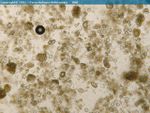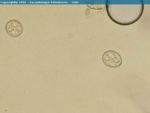Difference between revisions of "Coccidiosis - Cattle"
Jump to navigation
Jump to search
(Created page with 'thumb|right|150px|''Eimeria'' sp. of ruminants - Joaquim Castellà Veterinary Parasitology Universitat Autònoma de Barcelona [[Image:Coccidia ooc…') |
m (Text replace - 'Intestine Diarrhoea - Pathology' to 'Diarrhoea') |
||
| Line 9: | Line 9: | ||
*''Eimeria bovis'' | *''Eimeria bovis'' | ||
**Endogenous stages in central lacteal of villi and epithelial cells of [[Caecum - Anatomy & Physiology|caecum]] and [[Colon - Anatomy & Physiology|colon]] | **Endogenous stages in central lacteal of villi and epithelial cells of [[Caecum - Anatomy & Physiology|caecum]] and [[Colon - Anatomy & Physiology|colon]] | ||
| − | **Causes [[ | + | **Causes [[Diarrhoea|diarrhoea]] and enteritis |
**Oocysts are 28x20μm | **Oocysts are 28x20μm | ||
**Moderately pathogenic | **Moderately pathogenic | ||
| Line 22: | Line 22: | ||
**Also occurs in suckler calves turned out in spring | **Also occurs in suckler calves turned out in spring | ||
| − | *''Eimeria alabamensis'' associated with [[ | + | *''Eimeria alabamensis'' associated with [[Diarrhoea|diarrhoea]] in calves after spring turnout |
*[[Materno-fetal immunity - WikiBlood#Passive transfer via colostrum|Passive immunity]] is sufficient during the neonatal period | *[[Materno-fetal immunity - WikiBlood#Passive transfer via colostrum|Passive immunity]] is sufficient during the neonatal period | ||
| Line 29: | Line 29: | ||
'''Diagnosis''' | '''Diagnosis''' | ||
| − | *History, clinical signs, [[ | + | *History, clinical signs, [[Diarrhoea|diarrhoea]] (often with blood) and a decrease in weight gain |
*Post-mortem | *Post-mortem | ||
Revision as of 19:21, 6 June 2010
- Many species affect cattle
- Cattle under a year old are usually infected sporadically
- 2-3 week prepatent period
- Eimeria bovis
- Eimeria zuernii
- Endogenous stages in connective tissue of lamina propria of the lower small intestine and in the epithelial cells of the caecum and colon
- More pathogenic than Eimeria bovis
- Causes blood stained dysentery, tenesmus and sloughed mucosa
- Oocysts are spherical and measure 16μm
- Mainly occurs in calves in poor conditions and bought-in calves
- Also occurs in suckler calves turned out in spring
- Eimeria alabamensis associated with diarrhoea in calves after spring turnout
- Passive immunity is sufficient during the neonatal period
- Can be concurrent with cryptosporidium, viral and bacterial agents
Diagnosis
- History, clinical signs, diarrhoea (often with blood) and a decrease in weight gain
- Post-mortem
- High faecal oocyst count
- However, healthy animals can pass millions of oocysts from mixed species infections which have no pathogenic significance
- Animals may die before oocysts are shed
Control
- Improve husbandry
- Improve sanitation
- Increase bedding
- Raise food and water troughs to avoid faecal contamination
- Preventative in-feed medication
- E.g. Decoquinate
- Injectable antiprotozoals may limit oocyst production but animals should still be moved to a clean environment
- E.g. Sulphamethoxypyridazine

